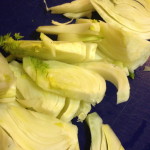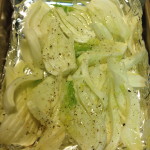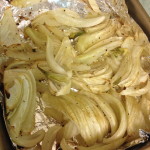This Meatless Monday, we feature a recipe for simple roasted fennel, as well as fennel growing, storage and preparation tips from our Vermont Fresh: A Fruit and Vegetable Handbook.
Lila Rees, a volunteer cooking, tasting and testing recipes out of the Vermont Fresh Handbook worked on this one. Her comments are below in italics.
Background
Fennel has feathery leaves that grow from a white, swollen stem often mistaken for a bulb. Although it was widely used in Greek and Roman times, fennel didn’t make it to the United States until the nineteenth century. Italians, however, have appreciated the anise-flavored vegetable for ages, even when the rest of the world did not. An American official abroad in Italy discovered the delights of fennel in 1824, when he mailed seeds back home to former President Thomas Jefferson. Jefferson grew the seeds in his famous garden and came to regard it as one of his favorite vegetables. Some people find the strong, anise-like flavor of fennel too intense, but cooked properly and tempered with other flavors, fennel can be a true delicacy.
Growing Tips
Despite the fact that fennel originated in warm climates, it is a fairly hardy annual that appreciates cool weather and plenty of water. Well fertilized soils (enriched with compost) will produce the largest, sweetest “bulbs.” There are two primary types of fennel: bulbing and non-bulbing. Non-bulbing fennel is used as an herb and is grown for both leaves and seed, so it is indeed useful, but don’t be disappointed if you grow that type and it doesn’t have a bulb-like base! Direct-seed fennel in mid-spring, sewing seeds again in mid-summer for another crop in the fall. If you wish transplant seedlings, start them indoors about 4 weeks before planting outdoors. If the plants start to bolt (go to seed), remove the bolting stalks. Harvest fennel when the bulbs are about 3-4 inches across.
Storage
Fennel is sensitive to drying out, so it needs to be wrapped in plastic before being stored in the refrigerator. The bulb will store longer if the stems and leaves are removed, so if possible, use the greenery first. On its own, the bulb will keep for about a week. Keep fennel as close to freezing as possible without actually freezing it, which will damage quality.
Nutritional Benefits
Fennel’s flavor comes from a compound called anethole, which may be an anti-inflammatory agent. In addition to being full of Vitamin C, fennel is a good source of potassium, dietary fiber, folate, iron, phosphorus, and magnesium.
Preparation
The greenery on fennel is a good indication of its freshness; never choose fennel with wilted or dull tops. Bulbs should be firm, largely unblemished, and white-green in color. Smaller bulbs are milder, making them better suited for eating raw. Larger bulbs can be trimmed at the base, quartered, and then cooked in a variety of ways. Fennel is especially tasty when roasted or braised.
Meatless Monday Featured Recipe: Simple Roasted Fennel
Serves 4
(adapted from Diana Rattray, about.com)
- Photo courtesy of Lila Rees
- Photo courtesy of Lila Rees
- Photo courtesy of Lila Rees
Ingredients
- 2 bulbs fennel, greens removed
- 1 tablespoon olive oil
- 1 teaspoon salt
- ¼ teaspoon black pepper
- 2 teaspoons lemon juice
- Other seasoning as desired
Instructions
- Heat oven to 375°F.
- Line a medium-sized baking dish with aluminum foil.
- Quarter fennel, remove tough base, and slice into thin wedges.
- In a bowl, gently toss fennel wedges with olive oil, salt, pepper, and lemon juice (as well as other seasonings if desired). If you prefer, use a brush to coat fennel with oil and seasonings.
- Transfer fennel to baking dish and bake until tender, about 30 minutes. Stir slices midway through baking.
Notes from Lila:
This is probably the simplest and maybe one of the best ways to serve fennel. It just happens to be one of my favorite vegetables. The recipe called for two fennel bulbs, to serve 4, but I just prepared 1 (I only have to cook for 1 person), but personally, I can easily eat a full bulb of fennel (smaller bulb, and they only had small bulbs at the store) as a side dish. So I think two bulbs, in my opinion is two servings, depending on the size of the bulbs. I believe they were $1.99 each. I remove the stalks and save those later for soup stock. I also like to garnish with the fronds. The lemon was a nice touch.
To receive more recipes and tips on your favorite fruits and vegetables, download Vermont Fresh: A Fruit and Vegetable Handbook. We also need more volunteer home chefs for this project.
Vermont Foodbank fresh food initiatives would not be possible without your support. Please consider giving to the Vermont Foodbank today!





